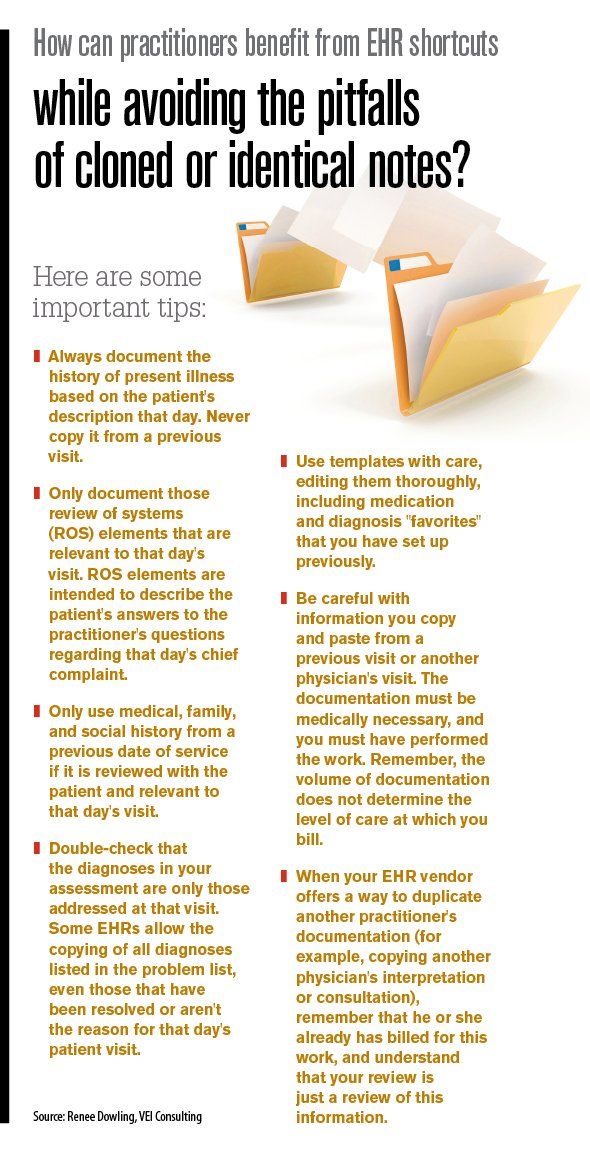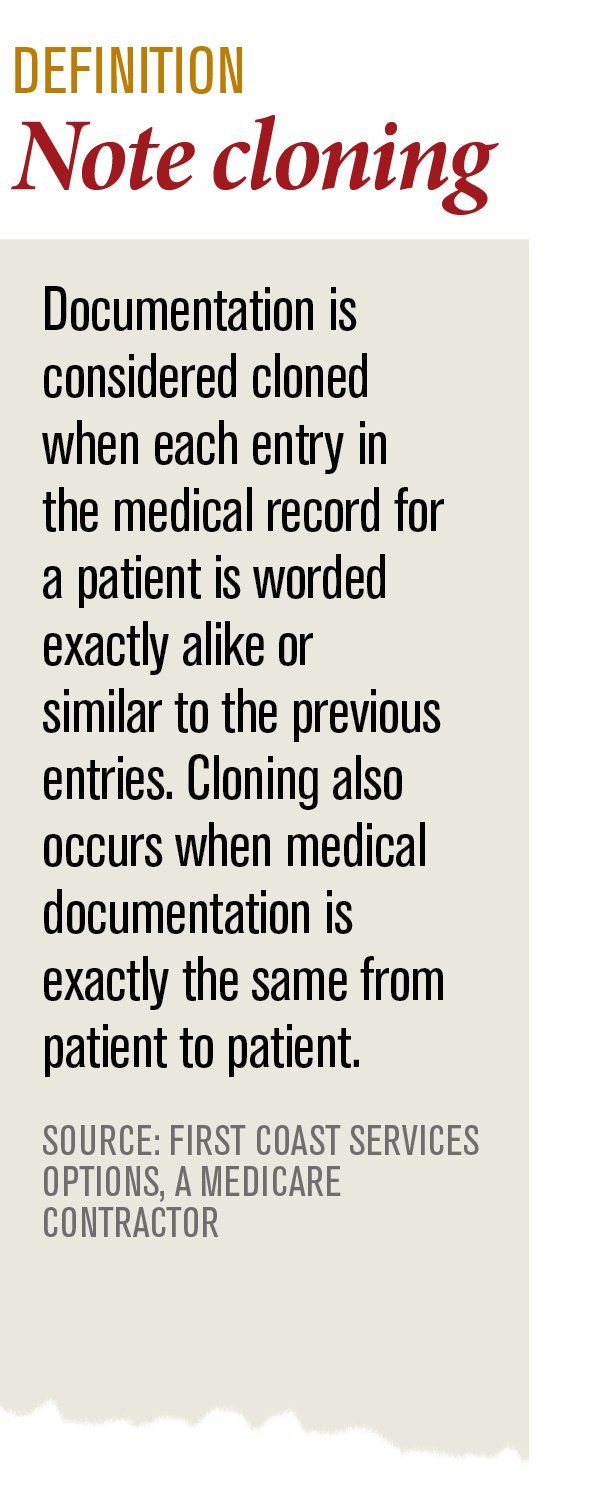Article
Avoiding EHR note ‘cloning’ while maintaining efficiency
The controversy over copy-paste in EHRs has been around for a long time, but it has recently gained new urgency.
In the wake of a recent government report that said the Centers for Medicare and Medicaid Services (CMS) is not doing enough to prevent electronic health record (EHR)-enabled billing fraud, some physicians say they’re concerned that CMS might outlaw copying and pasting of previous visit notes into current notes in EHRs. Such a move, they say, would make practices less efficient and impede patient care.8

"There comes a point where you can’t hamper the workflow of a doctor in the office if you want them to take good care of patients,” says Edward J. Gold, MD, an internist in Emerson, New Jersey.
Practice management and coding experts point out there’s no indication that CMS will prohibit physicians from using the copy-paste technique when they document their services. Nancy Enos, a coding consultant in Warwick, Rhode Island, says that CMS is aware of the nuances of how physicians use EHRs for documentation. She doesn’t believe its auditors will even penalize doctors who copy some superfluous elements into their notes as long as they don’t use the longer notes to justify higher codes.
On the other hand, physicians who copy whole notes from visit to visit had better be careful and watch their backs, warns Ed Hock, a director of The Advisory Board, a consulting firm. “It won’t be long until that type of practice comes home to roost, because there’s no tolerance within CMS and other organizations for inaccurate records, particularly those done with an eye toward maximizing reimbursement,” he says.
Inspector General report
The controversy over copy-paste in EHRs has been around for a long time, but it has recently gained new urgency.
In September 2012, following media reports about Medicare billing fraud, Health and Human Services (HHS) Secretary Kathleen Sebelius and Attorney General Eric Holder warned providers against using EHRs to pad charges. In January, a report from the HHS Office of Inspector General (OIG) asserted that CMS had not provided adequate training to its contractors on how to look for EHR-enabled fraud, such as upcoding related to the copying of visit notes.
In a response to the OIG report, CMS agreed that it should train its Medicare carriers and recovery audit contractors more thoroughly in this area. But it did not say there was anything inherently wrong with copy-paste.
Hock views CMS’ current focus on note cloning as part of its ongoing effort to ensure that the documentation supporting Medicare charges is accurate and complete. Practices should focus on the overall improvement of documentation and not just on copy-paste, he stresses. But this area does deserve additional scrutiny because of the OIG report, he adds.

Whole-note cloning
Experts agree that the real problem here is whole-note cloning, which may or may not indicate fraud. While many doctors copy notes to speed documentation, Enos says, “It can become a bad habit, where they’re copying information that’s not really relevant to the current encounter.”
For example, she says, “It’s impossible for a record to be valid if it contains a full review of systems and a full physical exam on a patient who comes in for a bloody nose.”
Doctors should always review copied notes to make sure they’re accurate and relevant, she adds. “Whether they’re copying and pasting or using preprogrammed text or ‘smart sets,’ they need to be trained to edit and to add remarks to personalize the note to the patient for that day,” she says. “Otherwise, they come across as canned notes.”
Gold agrees that whole-note cloning is wrong. But he sees nothing wrong in copying portions of a past note that have not changed since the last visit. For example, he customarily copies social and family histories. “If your father died of a heart attack, he died of a heart attack on every visit,” he says.
Similarly, he says, “If a patient has congestive heart failure and was in the hospital in 2007 and 2009, that information belongs in my note. But I don’t need to type that out each time. The fact that he was hospitalized in those two years didn’t change.”
If Gold had to reenter this type of information and other parts of a patient’s medical history every time the patient came in, visits would take far longer than 10 minutes each, he notes. “I could do that, but I could see only one patient every half hour, and I would want to get three times as much as I get paid now.”
Like Gold, Kenneth Kubitschek, MD, an internist in Asheville, North Carolina, is a veteran EHR user. Not only does he copy past notes related to family/social and medical history, he also moves forward certain parts of past physical exams. “If I do a cardiac exam on a patient ten times, those are probably going to be the same cardiac exam, whether I dictate it, write it, or copy and paste it,” he says.
“The key is whether or not the information is reviewed. If I’m asking you about your heart, I have a certain set of questions. Whether I copy them from the previous note and review and adjust them, or whether I dictate them new, it’s going to be the same.
“My feeling is, if I bring forward information, I’m reviewing it. If I’m reviewing it, it becomes mine. Whether I redo it exactly the same way, or I copy and paste it to be more efficient, I don’t think that’s fraud or poor medical practice. It all depends on how you handle the tool.” he says.
How to protect yourself
To ensure that they’re not at risk for a CMS audit because of copy-paste, “Practices must be much more proactive in doing coding audits and looking at the coding patterns of their physicians,” says Cindy Dunn, RN,
FACMPE, a consultant for the Medical Group Management Association. “They should do an annual audit to make sure that the documentation supports the code levels selected.”
Dunn suggests that practices compare the documentation and coding of their physicians. If a doctor is doing too much copying and pasting, he or she may need additional training on how to use the EHR.
Many physicians have problems with the drop-down templates in EHRs. To accelerate documentation and spend less time entering data, they may be tempted to take shortcuts that increase the practice’s
exposure to outside audits.
Practice leaders need to consider this when they look for solutions to excessive copying and pasting, Dunn says. “Maybe it’s having a scribe with the physician or having a nurse complete some portions of the chart that they’re qualified to do. In one practice that’s very proactive, patients start the note themselves in a kiosk in the reception area. They review their names and do their med lists [on the system] before the nurse takes them back to the exam room. That’s what you have to look for in your practice,
depending on what your practice culture will permit.”
Gold uses his staff to help him enter data in the EHR. When a patient comes in, his medical assistant takes the patient’s blood pressure and vital signs, reconciles the medication list, and updates the social history. But Gold says he still needs to copy some past notes to document efficiently. “If you’re not allowed to start from an established base, you have to start all over again,” he says.
To document visits correctly in your EHR, a little common sense goes a long way. Don’t copy whole notes, carefully review and edit whatever you do copy, and use your staff and patients to help enter the necessary data. Finally, remember that having the right information in your note, and nothing else, will help provide the best possible care to your patients.





